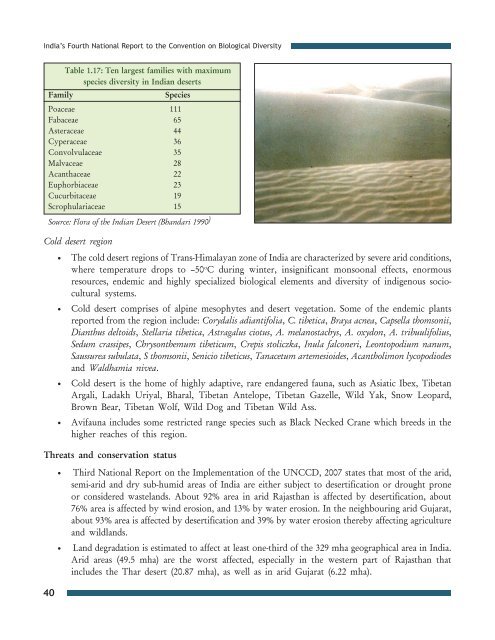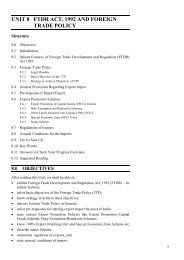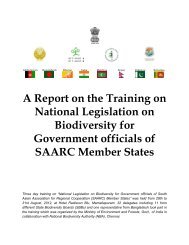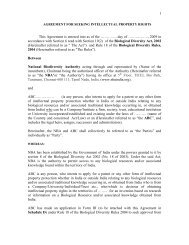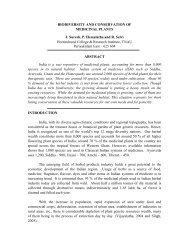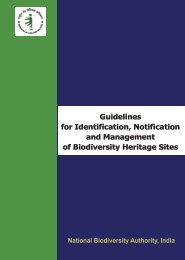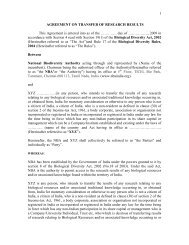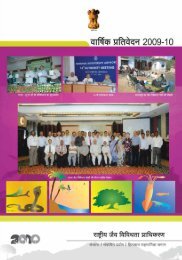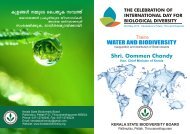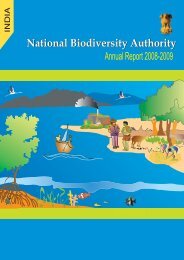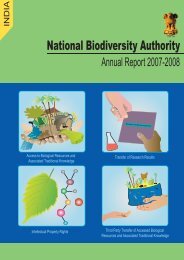Part 1 - English version (PDF) - Convention on Biological Diversity
Part 1 - English version (PDF) - Convention on Biological Diversity
Part 1 - English version (PDF) - Convention on Biological Diversity
You also want an ePaper? Increase the reach of your titles
YUMPU automatically turns print PDFs into web optimized ePapers that Google loves.
India’s Fourth Nati<strong>on</strong>al Report to the <str<strong>on</strong>g>C<strong>on</strong>venti<strong>on</strong></str<strong>on</strong>g> <strong>on</strong> <strong>Biological</strong> <strong>Diversity</strong><br />
Table 1.17: Ten largest families with maximum<br />
species diversity in Indian deserts<br />
Family<br />
Species<br />
Poaceae 111<br />
Fabaceae 65<br />
Asteraceae 44<br />
Cyperaceae 36<br />
C<strong>on</strong>volvulaceae 35<br />
Malvaceae 28<br />
Acanthaceae 22<br />
Euphorbiaceae 23<br />
Cucurbitaceae 19<br />
Scrophulariaceae 15<br />
Source: Flora of the Indian Desert (Bhandari 1990 )<br />
Cold desert regi<strong>on</strong><br />
<br />
<br />
<br />
<br />
The cold desert regi<strong>on</strong>s of Trans-Himalayan z<strong>on</strong>e of India are characterized by severe arid c<strong>on</strong>diti<strong>on</strong>s,<br />
where temperature drops to –50 o C during winter, insignificant m<strong>on</strong>so<strong>on</strong>al effects, enormous<br />
resources, endemic and highly specialized biological elements and diversity of indigenous sociocultural<br />
systems.<br />
Cold desert comprises of alpine mesophytes and desert vegetati<strong>on</strong>. Some of the endemic plants<br />
reported from the regi<strong>on</strong> include: Corydalis adiantifolia, C. tibetica, Braya acnea, Capsella thoms<strong>on</strong>ii,<br />
Dianthus deltoids, Stellaria tibetica, Astragalus ciotus, A. melanostachys, A. oxyd<strong>on</strong>, A. tribuulifolius,<br />
Sedum crassipes, Chrys<strong>on</strong>themum tibeticum, Crepis stoliczka, Inula falc<strong>on</strong>eri, Le<strong>on</strong>topodium nanum,<br />
Saussurea subulata, S thoms<strong>on</strong>ii, Senicio tibeticus, Tanacetum artemesioides, Acantholim<strong>on</strong> lycopodiodes<br />
and Waldhamia nivea.<br />
Cold desert is the home of highly adaptive, rare endangered fauna, such as Asiatic Ibex, Tibetan<br />
Argali, Ladakh Uriyal, Bharal, Tibetan Antelope, Tibetan Gazelle, Wild Yak, Snow Leopard,<br />
Brown Bear, Tibetan Wolf, Wild Dog and Tibetan Wild Ass.<br />
Avifauna includes some restricted range species such as Black Necked Crane which breeds in the<br />
higher reaches of this regi<strong>on</strong>.<br />
Threats and c<strong>on</strong>servati<strong>on</strong> status<br />
<br />
<br />
Third Nati<strong>on</strong>al Report <strong>on</strong> the Implementati<strong>on</strong> of the UNCCD, 2007 states that most of the arid,<br />
semi-arid and dry sub-humid areas of India are either subject to desertificati<strong>on</strong> or drought pr<strong>on</strong>e<br />
or c<strong>on</strong>sidered wastelands. About 92% area in arid Rajasthan is affected by desertificati<strong>on</strong>, about<br />
76% area is affected by wind erosi<strong>on</strong>, and 13% by water erosi<strong>on</strong>. In the neighbouring arid Gujarat,<br />
about 93% area is affected by desertificati<strong>on</strong> and 39% by water erosi<strong>on</strong> thereby affecting agriculture<br />
and wildlands.<br />
Land degradati<strong>on</strong> is estimated to affect at least <strong>on</strong>e-third of the 329 mha geographical area in India.<br />
Arid areas (49.5 mha) are the worst affected, especially in the western part of Rajasthan that<br />
includes the Thar desert (20.87 mha), as well as in arid Gujarat (6.22 mha).<br />
40


